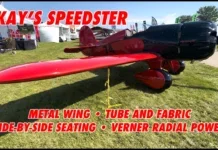
Practice, practice, practice – it’s what we all tell folks to do before they head to the Fiske Arrival and the great AirVenture experience! Flying in to the “the show” is a bucket list item for most pilots, and it requires you to be sharp–but is flying at 90 knots enough?
I went out this morning and did my usual annual tune-up, and here is my routine. Yes–you need to be able to fly your airplane at 90 knots if it is capable of doing so safely. So getting used to the speed again (how often do you do this?) is useful. But I just holding speed isn’t enough–you need to be able to do it while holding altitude, staying directly over a line on the ground (on the actual arrival, it’s the railroad tracks), and look outside for traffic–all at the same time.
For many, establishing the configuration is tough in itself, so I make sure that I start up high, pick a definite point on a road up ahead, and descend to 1000′ AGL (which is where the 1800′ MSL at Oshkosh comes from. I try to hit the speed and altitude right over the road a mile before my spot–that’s what you’ll want to do at Fiske. Be established BEFORE you get to Fiske remember. That’s the first exercise, and today, it worked out pretty well.
Next, I fly down the road, maintaining altitude and airspeed within a couple of knots and fifty feet. And I LOOK OUTSIDE. It’s important not to fixate on the instruments–and also not to just look straight ahead. Keep that head on a swivel, do a scan, then glance inside, make any corrections, then get back outside. I did this for about ten miles–longer than you’ll need at Oshkosh.
While practicing this, I checked power settings and temperatures, just to make sure I’d have no surprises on the actual day– know that your airplane can handle it, and jot a few notes about what works. Just be aware that if you’re practicing at altitude, as I was (we live at 4500′ MSL), you might have to adjust when you get to Wisconsin.
Finally–if you plan to use your autopilot to help maintain altitude, practice with that. Many autopilots will not allow you to use JUST altitude hold–they’ll be in heading or NAV mode as well, and you can’t just go from Fiske to Ripon in a straight line according to the NOTAM. So if you plan to use it on the actual day, practice, practice, practice.
Practice a few breakouts, as if you have been cut off, or someone gets slow in front of you. It WILL happen for real. Turn out, establish a climb, and get out of Dodge–safely. Head back for another try.
Ninety knots? Great practice–but make sure you do all of the other stuff as well. Then go practice landings with a different traffic pattern each time, and at different speeds and bank angles. Remember: Spot landings!
See you at the show!














